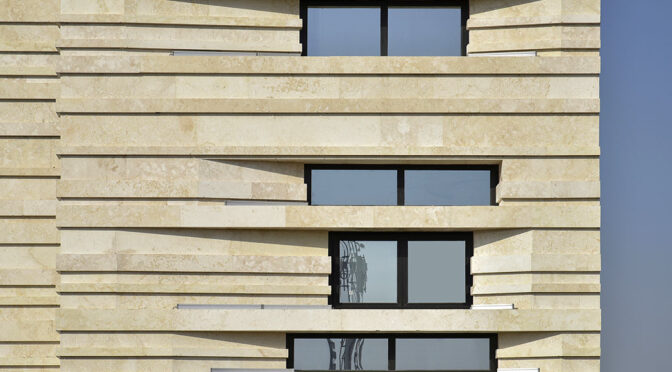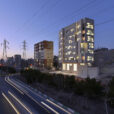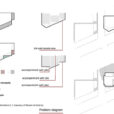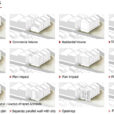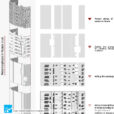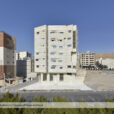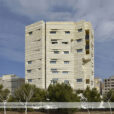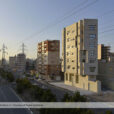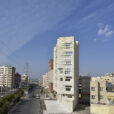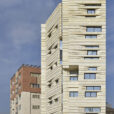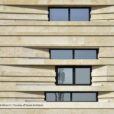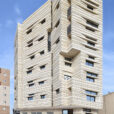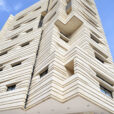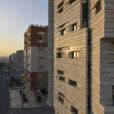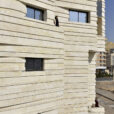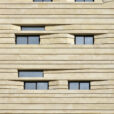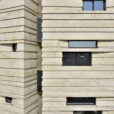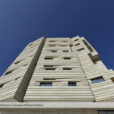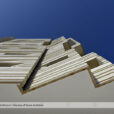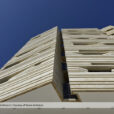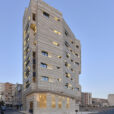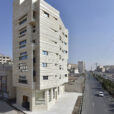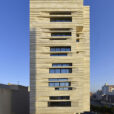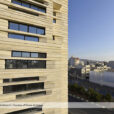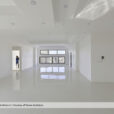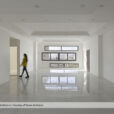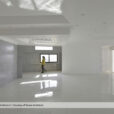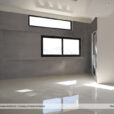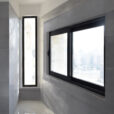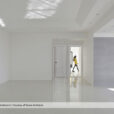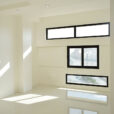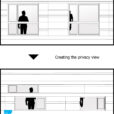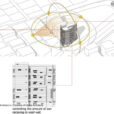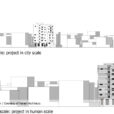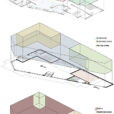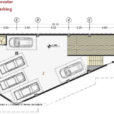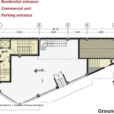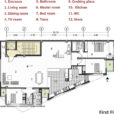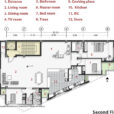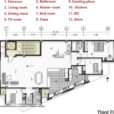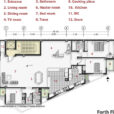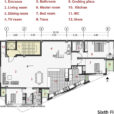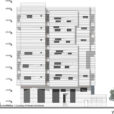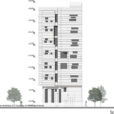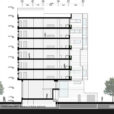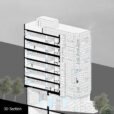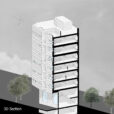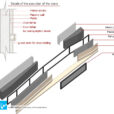ساختمان مسکونی آوینی
دفتر معماری هرم (مرتضی علینیا مقدم، حمید بابایی)
راهیافته به مرحله نیمهنهایی چهارمین دوره جایزه شایستگی معمار ایرانی (۱۴۰۰)
موقعیت: قم، ایران
تاریخ: ۱۳۹۷
مساحت: ۱۸۴۰ مترمربع
وضعیت: ساختهشده
کارفرما: سالار نیکوگفتار
همکاران طراحی: بهاره شیسی، مرضیه گلشاهی، فاطمه اسدسلیمانی، اندیشه اسکویی، احسان کازرونی، الیکا زارعی، کاظم رضایانی
اجرا: سالار نیکوگفتار، کاظم رضایانی
عکس: استودیو دید، بهاره شیسی
خانه
خانه فضایی است برای آرامش، برای سکوت، برای گفتگو. یکی از مهمترین ویژگیهای خانه، خلوص فضایی و استفاده از هندسه مناسب برای فضاهای عملکردی است. در طراحی خانه، اولویت بیشتر از فرم بیرونی، به داخل بنا مربوط میشود و برای رسیدن به کیفیت مناسب، خانه باید در پلان حل شود، چرا که پلانهایی با فضاهای دارای تناسب درست و خلوص فضایی، آسایش محیطی بیشتری را به کاربر ارائه میدهند. از اینرو، در طراحی فضاهای مسکونی، پلانی که پاسخگوی عملکردهای درونی پروژه و آسایش محیطی کاربر باشد، از اهمیت بالایی برخوردار است. از طرف دیگر، ساختمانهای مسکونی که در بافت شهری قرار میگیرند، نیازمند ارتباط و دیالوگی بین خود، شهر و زمینه مورد نظر هستند؛ پروژه باید خود را در بافت جای داده، با محیط ارتباط برقرار کرده و جایگاه خود را در شهر پیدا کند. در همین راستا، ساختمان مسکونی آوینی چالشی است بین پلان و شهر، دیالوگی است بین درون و بیرون، بین عملکرد و فرم، بین مجسمه و فضا.
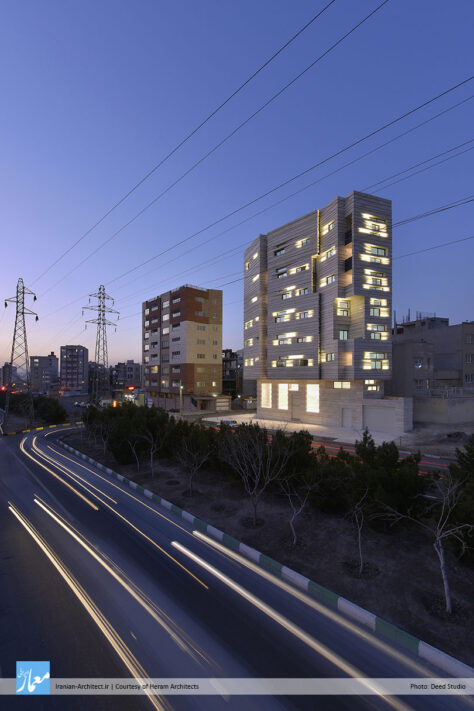
زمینه | سایت
ساختمان مسکونی آوینی در شهر قم واقع شده و دارای ۸ طبقه، ۶ واحد مسکونی، یک واحد تجاری و یک طبقه پارکینگ است. زمین پروژه دارای هندسهای ناموزون و اضلاعی با زوایای متفاوت است، به گونهای که طراحی پلان در آن با مشکلات و چالشهای فراوانی همراه بود. این سایت از یک ضلع به سمت خیابان اصلی، و از ضلع دیگر به یک کوچه منتهی میشود. با توجه به ضوابط شهرداری و مقدار کنسولها در راستای اضلاع زمین، چالش اصلی، ایجاد پلانی با بیشترین بازدهی و عدم وجود فضاهای پرت بود. از طرف دیگر، با توجه به قرارگیری پروژه در کنار خیابان اصلی، و پرتردد و بازبودن محیط اطراف آن، مسئله آیکونیکبودن پروژه در زمینه نیز مطرح بود، چالشی که با قرارگیری پروژه در محیط نمایان میشد و فرم نیز باید در دیالوگی با درون پروژه شکل میگرفت.

پلان
با توجه به هندسه زمین که دارای خطوطی با زوایای متفاوت است، حلکردن فضاهای داخلی و طراحی پلانی با بیشترین بازدهی، مهمترین مسئله پروژه در نظر گرفته شد. در روش طراحی عمومی و آنچه از گذشته انجام میشد، طراحی پلان با خطوطی هماهنگ با خطوط زمین و در راستای آنها شکل میگرفت. بدینترتیب، در پلانهایی که خطوط زمین آنها دارای زوایای متفاوتی بود، فضاهایی بدون استفاده و پرت شکل میگرفت که خلوص فضایی و تناسبات فضا را برای استفاده درست کاربر از بین میبرد. بر این اساس، چالش اصلی در این پروژه، طراحی پلانی عملکردی و خالص، با توجه به محدودیت زمین، خطوط سایت و ضوابط شهری بود.
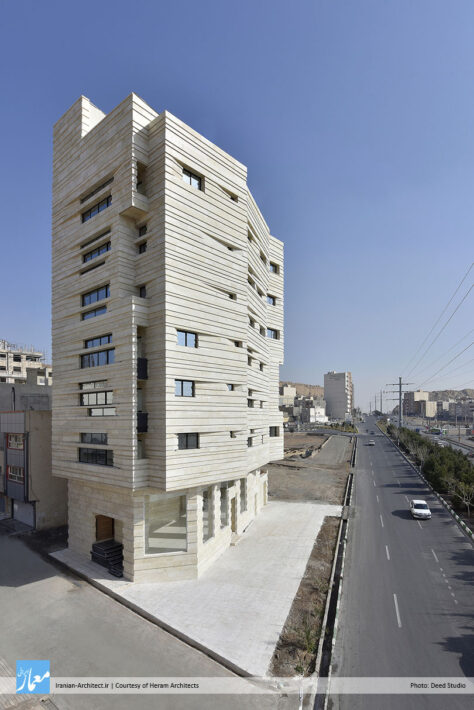
طرح
با توجه به محدودیتهای پروژه، در ابتدا، حلکردن پلان با بیشترین بازدهی ممکن که دارای خلوص هندسی و تناسبات درست باشد، مورد توجه قرار گرفت. از اینرو، در روند شکلگیری پلان، ما به خطوطی رسیدیم که از طریق کنسولها ایجاد میشد. در این مرحله، برای شکلگیری خلوص فضایی و رسیدن به هندسه درست در پلان، کنسولها و نحوه قرارگیری آنها با توجه به فضاهای درونی تغییر پیدا کردند، به گونهای که در تبعیت از فضاهای داخلی و در راستای خطوط داخلی پلان، کنسولها نیز تغییر زاویه داده و با خطوط داخلی پلان هماهنگ شدند. در نتیجه، به پلانی با بیشترین بازدهی رسیدیم، پلانی که کوچکترین فضای نامتناسبی نداشت. در همین روند بود که حجم بیرونی بنا نیز در دیالوگی دو سویه مابین پلان داخلی و خطوط شهری شکل گرفت؛ حجم دیالوگی شد بین درون و بیرون پروژه، فرمی متاثر از فضای داخلی و اتفاقات درونی بنا، و همچنین تاثیرگذار و تاثیرپذیر از شهر و خطوط سایت. در نتیجه، به حجمی دست پیدا کردیم که خود را در بافت شهری، به صورت شاخص نمایان میکند. این حجم از طرفی در دیالوگ با فضاهای داخلی و پلان است و از طرف دیگر، هماهنگی خود را با خطوط شهر (قسمت آشپزخانه) برقرار خواهد کرد.
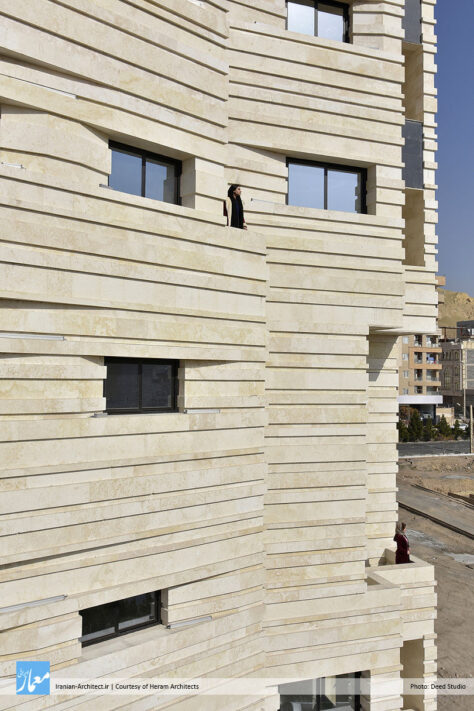
مقیاس | بافت | متریال
پس از شکلگیری حجمی پروژه و همینطور حلکردن پلان داخلی، برای ایجاد بازشوها دیتیلی در نظر گرفته شد که بتواند بر جنبه آیکونیکبودن بنا تاکید کند. بازشوها به مثابه برشهایی از داخل یک سنگ بزرگ ایجاد شدند که گویی مجسمهای در حال شکلگرفتن است. از طرف دیگر، این بازشوها پاسخی برای مسئله محرمیت و دید کنترلشده در زمینه مورد نظر (شهر قم) نیز بود. بدینترتیب، پروژه خود را مانند مجسمهای در شهر نمایان کرد که خطوطی (بازشوها) بر روی آن حکاکی شده است. در واقع، پروژه به صورت سنگی یکپارچه و سفیدرنگ (به دلیل شاخصکردن پروژه در بافت) دیده شده که گویی با چکشکاری و حکاکیهای انجامشده روی آن، مجسمهای از دل این سنگ یکپارچه نمایان شده است.
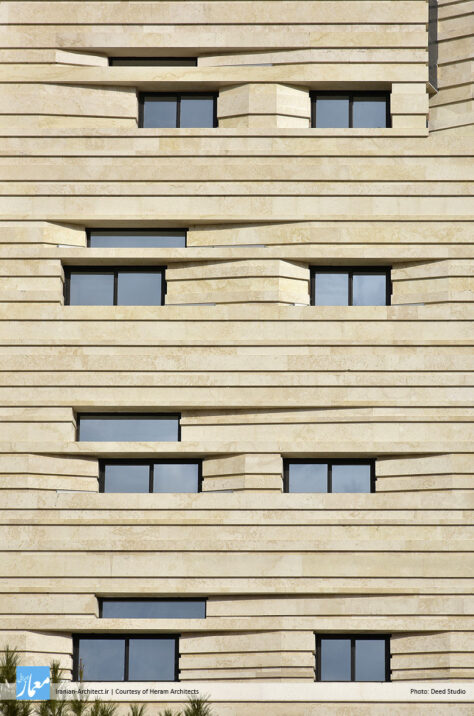
به دلیل قرارگیری پروژه در بافت باز محیط، ما به دو مقیاس متفاوت از لحاظ بصری توجه کردیم: مقیاس شهری و دور پروژه که همانند مجسمهای است با بازشوهایی که روی آن را برش داده، و مقیاس دیگر که مقیاس انسانی و نزدیک پروژه بود. برای نمایانکردن دیتیلهای ریز مجسمه در مقیاس انسانی، ما بافتی از سنگهای نامنظم را روی پروژه شکل دادیم که این خطوط با نزدیکشدن به پروژه، خود را نمایان میکنند. این بافت با قرارگیری سنگهایی به رنگ سفید و با عرضهای متفاوت (۲۰،۱۰ ،۳۰ و ۴۰ سانتیمتری) و همچنین دارای عمق، بر روی هم شکل گرفته است. بدینترتیب، جنبه آیکونیکبودن پروژه در هر دو مقیاس شهری و انسانی رعایت شده است؛ در مقیاس شهری و حجم کلی از پروژه، فقط بازشوها نمایان است و پس از نزدیکشدن به پروژه و در مقیاس انسانی، خطوط نامنظم قرارگیری سنگها نمایان شده و دیتیلی دیگر از مجسمه را نشان میدهند.
Avini Residential Building
Heram Architects (Morteza Alinia Moghadam, Hamid Babaei)
Semi-Finalist of Iranian Architect Merit Award 2021
Location: Qom, Iran
Date: 2018
Area: 1,840 sqm
Status: Completed
Client: Salar Nikoogoftar
Design Team: Bahareh Sheisi, Marziyeh Golshahi, Fatemeh Asad Soleymani, Andisheh Oskuyi, Ehsan Kazerooni, Elika Zarei, Kazem Rezayani
Construction: Salar Nikoogoftar, Kazem Rezayani
Photo: Deed Studio, Bahareh Sheisi
Home
Home is a space for peace, silence and dialogue. One of the most important features of a house is the spatial purity and the use of proper geometry for functional spaces. The priority in the design of the house is more related to the inside of the building, rather than outer form of the building, and to achieve proper quality, the house should be resolved in the plan. Plans with spaces with correct fit and spatial purity, provide a more environmental comfort for the user. Hence, in the design of residential spaces, a plan that responds to the internal functions of the project and the user’s environmental comfort, is of great importance. On the other hand, residential buildings that are placed in urban context, require a correlation and dialogue between themselves, the city and the context in question. The project must fit itself in the context, communicate with the environment and find its place in the city. Avini residential building is a challenge between the plan and the city, and a dialogue between the inside and the outside, between the function and the form, between the sculpture and the space.
Context | Site
Avini residential building is located in the city of Qom, with 8 floors, 6 residential units, a commercial unit and a parking floor. The land has an uneven geometry and sides with different angles. The geometry of the site is such that designing the plan in it, involves many problems and challenges. The project site leads from one side to the main street and from the other side to an alley. Given the municipality’s standards and the amount of consoles along the sides of the land, the main challenge is to create a plan with the highest efficiency and with the absence of remote spaces. On the other hand, considering the location of the project along a main and busy street and the openness of its surroundings, the issue of project being iconic in the context, is raised; A challenge that was presented by placement of the project in the environment, and should take form in a dialogue with the inner shape of the project.
The Plan
Considering the geometry of the land, which has lines with different angles, resolving internal spaces and designing a plan with highest efficiency, is considered as the most important issue in the project. In conventional design and what was done in the past, the design of the plan was formed in line with the lines of the land. Thus, in plans that their land lines had different angles, useless and remote places would have formed that eliminated the spatial purity and space proportions for proper use of the user. The main challenge in the project was the design of a pure and functional plan, by considering the constraints of the land, site lines and urban standards.
The Design
Due to the project’s limitations, resolving the plan with highest possible efficiency that has geometric purity and correct proportions, was first considered. Hence, in the process of developing our plan, we arrived at lines that were created through consoles. At this stage, for the formation of spatial purity and reaching the correct geometry in the plan, the consoles and the way of placing them, were changed with respect to the inner spaces. In such a way that, in accordance with the interior spaces and along the inner lines of the plan, the consoles also changed angle and were aligned with the interior lines of the plan. As a result, we achieved a plan with the highest efficiency; A plan that did not have the slightest disproportionate space. In the same process, the exterior volume of the building was also formed in a two-way dialogue between the inner plan and the urban lines. The volume became a dialogue between the inside and outside of the project, a form affected by the interior and internal events of the building, as well as influencing and being influenced by the city and site lines. As a result, we have achieved a volume that shows itself as an indicator in urban context. This volume, on one hand, is in the dialogue with the inner spaces and the plan, and on the other hand, it will coordinate with the city lines (kitchen section).
Scale | Texture | Material
After volumetric formation of the project, as well as the resolution of the internal plan, a detail was considered for creating openings, to emphasize the iconic aspect of the building. Openings were created like slices from inside of a large stone, as if a sculpture is forming. On the other hand, these openings were also an answer to the problem of the confidentiality and controlled vision in the area (Qom city). In this way, the project displayed itself as a sculpture in the city, with lines (openings) carved on it. The project was seen as a white and integrated stone (due to the project’s indexing in the context), as if with hammering and engraving performed on it, a sculpture was appeared in the heart of this unified stone.
Due to the location of the project in the open context of environment, we looked at two visually different scales: the urban scale and around the project, which is the same sculpture with openings that had been carved on it, and another scale that was human scale and close to the project. To illustrate the small details of the sculpture in human scale, we formed a texture of irregular rocks on the project, which by getting close to the project, these lines show themselves. This texture was formed by placing rocks of different width (10, 20, 30 and 40 cm) and also having a depth, on each other. In this way, the aspect of project being iconic was carried out in both urban and human scales. On the urban scale and the overall size of the project, only the openings are visible, and after approaching the project and on a human scale, irregular lines of rocks appear and show another detail of sculpture.

